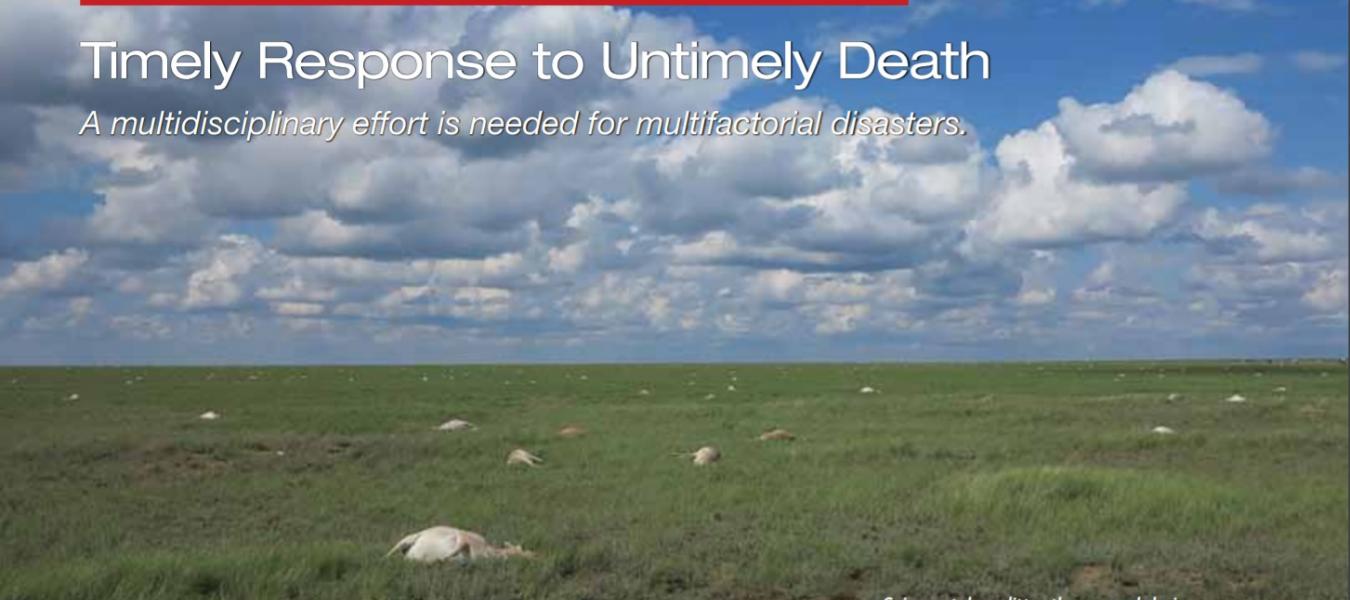On a hot and humid Sunday, in May 2015, reports began coming in to the saiga research team in Kazakhstan of deaths at a calving site where about 62,000 saigas were concentrated. The team located the herd and on upon arrival at the site, recorded 100 deaths, which they estimated had died within the past one to two days. In the following two days, the count rose to 400, then 1,000, then 20,000. Nine days later there were no known survivors. Tragically, rangers at another site reported deaths among an aggregation of 8,000 saigas. A second team of scientists was formed and arrived at the site. By then, many hundreds of animals were sick or dying. And two days later, none had survived. Within three weeks from the first reported deaths, more than 200,000 saiga antelopes died in calving aggregations across several hundred kilometers of central Kazakhstan, representing more than eighty percent of the Betpak-dala population, and more than sixty percent of the global population of the species.
By Richard A. Kock and E.J. Milner-Gulland
Reproduced by kind permission of 'Natural History' magazine. First published in the April 2018 issue. Every year at calving time for the past six years, an international team of researchers-under the authority of the government of Kazakhstan and in collaboration with Kazakhstan research institutions-has been monitoring the health of the saiga antelope population in central Kazakhstan.
Saigas once roamed widely over steppes and semi-arid deserts from southeastern Europe to Mongolia and into China. Now, one population of Saiga tatarica tatarica, the nominate subspecies, exists in Russia, three in Kazakhstan, one of which migrates to Uzbekistan in the winter. There is another distinct sub-species, Saiga tatarica mongolica, in western Mongolia. Populations in the rest of their once-wider range are extinct.
Since 2002, the World Conservation Union's (IUCN) Red List has listed saigas, Saiga tatarica L., as Critically Endangered. The species was listed as lower risk-conservation dependent only in 2000, but then suffered a rapid, more than ninety percent, decline in its global population, due to poaching after the break-up of the Soviet Union, leading to a population of less than 50,000 in 2003.
As one of us (Milner-Gulland) reported in a 2001 paper in Oryx, the literature shows that "Saiga populations have fluctuated dramatically over the last century, principally as a result of hunting for meat and horns, and climatic variability. The horns (ling yang, 羚羊) are borne only by males and are used in traditional Chinese medicine. Data on historical changes in the numbers and range of the Mongolian subspecies are minimal. The nominate subspecies was heavily hunted in the nineteenth century, and by the time of the Soviet revolution was reduced to a few thousand individuals. A complete ban on hunting allowed populations to recover, and regulated commercial hunting was started in the 1950s. Regulated hunting, principally for meat, continued throughout the Soviet period. Since then, a collapse in funding and infrastructure for saiga management, combined with a disintegrating rural economy, has led to uncontrolled large-scale poaching for meat and horns."
From 2005 to 2015, some populations of the species started to recover. By 2015, there were more than 300,000 individuals in existence-of which 240,000, or more, were in the Betpak-dala population of Kazakhstan. In Soviet times, Kazakhstan's saiga populations were well monitored by teams of scientists from the Institute of Zoology of the Kazakhstan Academy of Sciences. After the break-up of the Soviet Union, monitoring became more patchy, due to lack of resources and capacity. However, in the last few years, detailed monitoring of the Betpak-dala population, and to a lesser extent the other populations, has restarted, led by the Kazakhstan government's Committee on Hunting and Forestry, with scientific input from the local non-government agency, the Association for the Conservation of Biodiversity in Kazakhstan. International veterinary researchers joined this effort, in response to a disease outbreak in the Ural population in 2010. In the Soviet literature, mass deaths from disease have been reported in 1974, 1981, 1988, and 2010. In 1974, the cause was foot-and-mouth disease from livestock (pre-vaccination), while in the other years, various types of pasteurellosis, a bacterial infection, were implicated.
In 2014, calving went without incident. The population appeared healthy and growing. Before the start of the 2015 calving season, aerial surveys determined the locations and sizes of gathering herds. By the start of calving, which happens over a wide area, monitoring teams were in place on the ground, scattered among the three saiga population sites in Kazakhstan. Over 240,000 females were aggregated in the Betpak-dala region in fifteen, or so, clusters.
A mass burial ground for dead saigas in Kazakhstan in 2015
On a hot and humid Sunday, May 10, reports began coming in to the team base of deaths at the Torgai site where about 62,000 saigas were concentrated. The team located the herd and on May 11, team members, upon arrival at the site, recorded 100 deaths, which they estimated had died within the past one to two days. In the following two days, the count rose to 400, then 1,000, then 20,000 by the 16th. By the 19th, there were no known survivors...
Download the full document from Natural History Magazine to read on.

